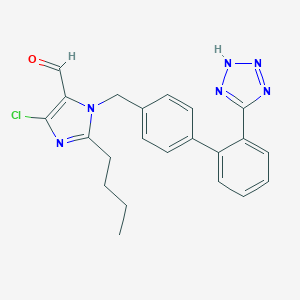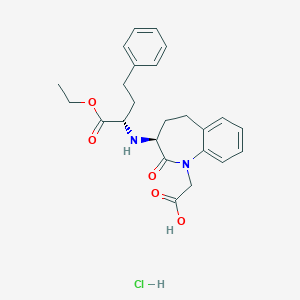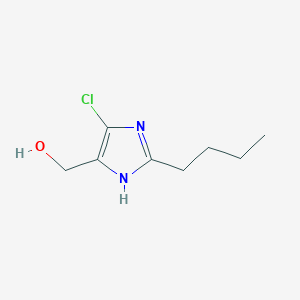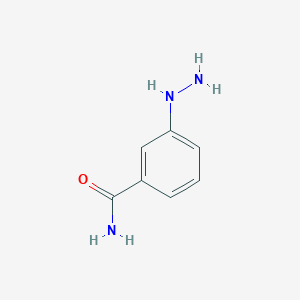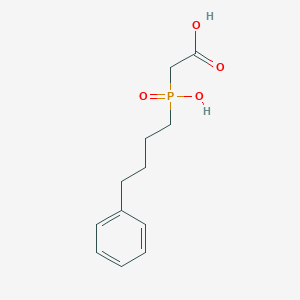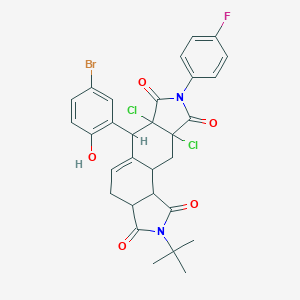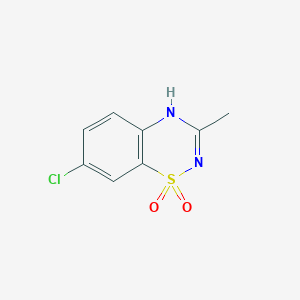
Abiraterona
Descripción general
Descripción
Abiraterona es un antiandrógeno potente que se utiliza principalmente en el tratamiento del cáncer de próstata metastásico resistente a la castración y el cáncer de próstata metastásico de alto riesgo sensible a la castración . Es un inhibidor selectivo de la enzima 17α-hidroxilasa/C17,20-liasa (CYP17), que desempeña un papel crucial en la biosíntesis de andrógenos . La this compound se administra a menudo en forma de su profármaco, acetato de this compound, para mejorar su estabilidad y absorción .
Aplicaciones Científicas De Investigación
La abiraterona tiene una amplia gama de aplicaciones de investigación científica:
Química: Se utiliza como compuesto modelo para estudiar los inhibidores enzimáticos esteroideos.
Biología: La this compound se emplea en la investigación sobre la biosíntesis de andrógenos y su inhibición.
Mecanismo De Acción
La abiraterona ejerce sus efectos inhibiendo de forma selectiva e irreversible la enzima 17α-hidroxilasa/C17,20-liasa (CYP17), que es esencial para la biosíntesis de andrógenos . Al bloquear esta enzima, la this compound reduce la producción de testosterona y otros andrógenos, lo que inhibe el crecimiento de las células de cáncer de próstata dependientes de andrógenos . Los objetivos moleculares incluyen las glándulas suprarrenales, los testículos y los tumores de próstata .
Compuestos similares:
Singularidad de la this compound: La singularidad de la this compound radica en su mecanismo de acción. Inhibe la biosíntesis de andrógenos a nivel enzimático, mientras que otros compuestos como la bicalutamida y la enzalutamida actúan a nivel del receptor . Esto hace que la this compound sea especialmente eficaz en los casos en que los inhibidores de la señalización del receptor de andrógenos son menos eficaces.
Análisis Bioquímico
Biochemical Properties
Abiraterone plays a significant role in biochemical reactions as it selectively and irreversibly inhibits CYP17 (17 alpha-hydroxylase/C17,20-lyase), an enzyme required for androgen biosynthesis . This enzyme is expressed in testicular, adrenal, and prostatic tumor tissues . The inhibition of CYP17 by Abiraterone leads to a decrease in the formation of the testosterone precursors dehydroepiandrosterone (DHEA) and androstenedione .
Cellular Effects
Abiraterone has profound effects on various types of cells, particularly cancer cells. By inhibiting androgen synthesis, Abiraterone reduces the availability of androgens, which are essential for the growth and survival of prostate cancer cells . This influences cell function, including impacts on cell signaling pathways, gene expression, and cellular metabolism .
Molecular Mechanism
The molecular mechanism of action of Abiraterone involves its binding to the CYP17 enzyme, thereby inhibiting its activity . This prevents the conversion of pregnenolone and progesterone to DHEA and androstenedione, respectively . As a result, the levels of these androgens are reduced, leading to decreased stimulation of androgen receptors and changes in gene expression in prostate cancer cells .
Temporal Effects in Laboratory Settings
In laboratory settings, the effects of Abiraterone have been observed to change over time . The pharmacokinetics of Abiraterone have been studied in healthy volunteers, with results indicating that the maximum plasma concentration was achieved under fasting conditions .
Dosage Effects in Animal Models
The effects of Abiraterone in animal models vary with different dosages
Metabolic Pathways
Abiraterone is involved in the metabolic pathway of androgen biosynthesis . It interacts with the CYP17 enzyme, which is a key enzyme in this pathway .
Métodos De Preparación
Rutas sintéticas y condiciones de reacción: La síntesis del acetato de abiraterona suele implicar un proceso de cuatro pasos a partir de la dehidroepiandrosterona . Los pasos clave incluyen:
Condensación: La dehidroepiandrosterona se condensa con hidrato de hidrazina en etanol utilizando ácido sulfúrico como catalizador para formar un intermedio de hidrazona.
Yodación: El intermedio se trata con yodo en presencia de 1,1,3,3-tetrametilguanidina para producir 17-yodoandrosta-5,16-dien-3β-ol.
Acoplamiento de Suzuki: El compuesto yodado se somete a acoplamiento cruzado de Suzuki con 3-(dietilboril)piridina utilizando un catalizador de paladio para formar this compound.
Acetilación: Finalmente, la this compound se acetila para producir acetato de this compound.
Métodos de producción industrial: La producción industrial del acetato de this compound implica rutas sintéticas similares, pero optimizadas para la fabricación a gran escala. Se emplean técnicas como la evaporación de disolventes, la compactación directa y la granulación por fusión para mejorar la biodisponibilidad y la estabilidad del producto final .
Análisis De Reacciones Químicas
Tipos de reacciones: La abiraterona se somete a varias reacciones químicas, entre ellas:
Oxidación: La this compound puede oxidarse para formar derivados hidroxilados.
Reducción: Las reacciones de reducción pueden convertir la this compound en sus correspondientes alcoholes.
Sustitución: La this compound puede participar en reacciones de sustitución, particularmente en presencia de halógenos.
Reactivos y condiciones comunes:
Oxidación: Se utilizan comúnmente reactivos como el permanganato de potasio o el trióxido de cromo.
Reducción: El borohidruro de sodio o el hidruro de aluminio y litio son agentes reductores típicos.
Sustitución: Se utilizan agentes halogenantes como el yodo o el bromo en condiciones suaves.
Productos principales: Los principales productos que se forman a partir de estas reacciones incluyen this compound hidroxilada, derivados de this compound reducidos y compuestos de this compound halogenados .
Comparación Con Compuestos Similares
Uniqueness of Abiraterone: Abiraterone’s uniqueness lies in its mechanism of action. It inhibits androgen biosynthesis at the enzymatic level, whereas other compounds like bicalutamide and enzalutamide act at the receptor level . This makes abiraterone particularly effective in cases where androgen receptor signaling inhibitors are less effective.
Propiedades
IUPAC Name |
(3S,8R,9S,10R,13S,14S)-10,13-dimethyl-17-pyridin-3-yl-2,3,4,7,8,9,11,12,14,15-decahydro-1H-cyclopenta[a]phenanthren-3-ol | |
|---|---|---|
| Source | PubChem | |
| URL | https://pubchem.ncbi.nlm.nih.gov | |
| Description | Data deposited in or computed by PubChem | |
InChI |
InChI=1S/C24H31NO/c1-23-11-9-18(26)14-17(23)5-6-19-21-8-7-20(16-4-3-13-25-15-16)24(21,2)12-10-22(19)23/h3-5,7,13,15,18-19,21-22,26H,6,8-12,14H2,1-2H3/t18-,19-,21-,22-,23-,24+/m0/s1 | |
| Source | PubChem | |
| URL | https://pubchem.ncbi.nlm.nih.gov | |
| Description | Data deposited in or computed by PubChem | |
InChI Key |
GZOSMCIZMLWJML-VJLLXTKPSA-N | |
| Source | PubChem | |
| URL | https://pubchem.ncbi.nlm.nih.gov | |
| Description | Data deposited in or computed by PubChem | |
Canonical SMILES |
CC12CCC(CC1=CCC3C2CCC4(C3CC=C4C5=CN=CC=C5)C)O | |
| Source | PubChem | |
| URL | https://pubchem.ncbi.nlm.nih.gov | |
| Description | Data deposited in or computed by PubChem | |
Isomeric SMILES |
C[C@]12CC[C@@H](CC1=CC[C@@H]3[C@@H]2CC[C@]4([C@H]3CC=C4C5=CN=CC=C5)C)O | |
| Source | PubChem | |
| URL | https://pubchem.ncbi.nlm.nih.gov | |
| Description | Data deposited in or computed by PubChem | |
Molecular Formula |
C24H31NO | |
| Source | PubChem | |
| URL | https://pubchem.ncbi.nlm.nih.gov | |
| Description | Data deposited in or computed by PubChem | |
DSSTOX Substance ID |
DTXSID80879993 | |
| Record name | Abiraterone | |
| Source | EPA DSSTox | |
| URL | https://comptox.epa.gov/dashboard/DTXSID80879993 | |
| Description | DSSTox provides a high quality public chemistry resource for supporting improved predictive toxicology. | |
Molecular Weight |
349.5 g/mol | |
| Source | PubChem | |
| URL | https://pubchem.ncbi.nlm.nih.gov | |
| Description | Data deposited in or computed by PubChem | |
Mechanism of Action |
Abiraterone is an orally active inhibitor of the steroidal enzyme CYP17A1 (17 alpha-hydroxylase/C17,20 lyase). It inhibits CYP17A1 in a selective and irreversible manner via covalent binding mechanism. CYP17A1 is an enzyme that catalyzes the biosynthesis of androgen and is highly expressed in testicular, adrenal, and prostatic tumor tissue. More specifically, abiraterone inhibits the conversion of 17-hydroxyprognenolone to dehydroepiandrosterone (DHEA) by the enzyme CYP17A1 to decrease serum levels of testosterone and other androgens. | |
| Record name | Abiraterone | |
| Source | DrugBank | |
| URL | https://www.drugbank.ca/drugs/DB05812 | |
| Description | The DrugBank database is a unique bioinformatics and cheminformatics resource that combines detailed drug (i.e. chemical, pharmacological and pharmaceutical) data with comprehensive drug target (i.e. sequence, structure, and pathway) information. | |
| Explanation | Creative Common's Attribution-NonCommercial 4.0 International License (http://creativecommons.org/licenses/by-nc/4.0/legalcode) | |
CAS No. |
154229-19-3 | |
| Record name | Abiraterone | |
| Source | CAS Common Chemistry | |
| URL | https://commonchemistry.cas.org/detail?cas_rn=154229-19-3 | |
| Description | CAS Common Chemistry is an open community resource for accessing chemical information. Nearly 500,000 chemical substances from CAS REGISTRY cover areas of community interest, including common and frequently regulated chemicals, and those relevant to high school and undergraduate chemistry classes. This chemical information, curated by our expert scientists, is provided in alignment with our mission as a division of the American Chemical Society. | |
| Explanation | The data from CAS Common Chemistry is provided under a CC-BY-NC 4.0 license, unless otherwise stated. | |
| Record name | Abiraterone [INN:BAN] | |
| Source | ChemIDplus | |
| URL | https://pubchem.ncbi.nlm.nih.gov/substance/?source=chemidplus&sourceid=0154229193 | |
| Description | ChemIDplus is a free, web search system that provides access to the structure and nomenclature authority files used for the identification of chemical substances cited in National Library of Medicine (NLM) databases, including the TOXNET system. | |
| Record name | Abiraterone | |
| Source | DrugBank | |
| URL | https://www.drugbank.ca/drugs/DB05812 | |
| Description | The DrugBank database is a unique bioinformatics and cheminformatics resource that combines detailed drug (i.e. chemical, pharmacological and pharmaceutical) data with comprehensive drug target (i.e. sequence, structure, and pathway) information. | |
| Explanation | Creative Common's Attribution-NonCommercial 4.0 International License (http://creativecommons.org/licenses/by-nc/4.0/legalcode) | |
| Record name | Abiraterone | |
| Source | EPA DSSTox | |
| URL | https://comptox.epa.gov/dashboard/DTXSID80879993 | |
| Description | DSSTox provides a high quality public chemistry resource for supporting improved predictive toxicology. | |
| Record name | (1S,2R,5S,10R,11S,15S)-2,15-dimethyl-14-(pyridin-3-yl)tetracyclo[8.7.0.0²,�.0¹¹,¹�] heptadeca-7,13-dien-5-ol | |
| Source | European Chemicals Agency (ECHA) | |
| URL | https://echa.europa.eu/information-on-chemicals | |
| Description | The European Chemicals Agency (ECHA) is an agency of the European Union which is the driving force among regulatory authorities in implementing the EU's groundbreaking chemicals legislation for the benefit of human health and the environment as well as for innovation and competitiveness. | |
| Explanation | Use of the information, documents and data from the ECHA website is subject to the terms and conditions of this Legal Notice, and subject to other binding limitations provided for under applicable law, the information, documents and data made available on the ECHA website may be reproduced, distributed and/or used, totally or in part, for non-commercial purposes provided that ECHA is acknowledged as the source: "Source: European Chemicals Agency, http://echa.europa.eu/". Such acknowledgement must be included in each copy of the material. ECHA permits and encourages organisations and individuals to create links to the ECHA website under the following cumulative conditions: Links can only be made to webpages that provide a link to the Legal Notice page. | |
| Record name | ABIRATERONE | |
| Source | FDA Global Substance Registration System (GSRS) | |
| URL | https://gsrs.ncats.nih.gov/ginas/app/beta/substances/G819A456D0 | |
| Description | The FDA Global Substance Registration System (GSRS) enables the efficient and accurate exchange of information on what substances are in regulated products. Instead of relying on names, which vary across regulatory domains, countries, and regions, the GSRS knowledge base makes it possible for substances to be defined by standardized, scientific descriptions. | |
| Explanation | Unless otherwise noted, the contents of the FDA website (www.fda.gov), both text and graphics, are not copyrighted. They are in the public domain and may be republished, reprinted and otherwise used freely by anyone without the need to obtain permission from FDA. Credit to the U.S. Food and Drug Administration as the source is appreciated but not required. | |
Retrosynthesis Analysis
AI-Powered Synthesis Planning: Our tool employs the Template_relevance Pistachio, Template_relevance Bkms_metabolic, Template_relevance Pistachio_ringbreaker, Template_relevance Reaxys, Template_relevance Reaxys_biocatalysis model, leveraging a vast database of chemical reactions to predict feasible synthetic routes.
One-Step Synthesis Focus: Specifically designed for one-step synthesis, it provides concise and direct routes for your target compounds, streamlining the synthesis process.
Accurate Predictions: Utilizing the extensive PISTACHIO, BKMS_METABOLIC, PISTACHIO_RINGBREAKER, REAXYS, REAXYS_BIOCATALYSIS database, our tool offers high-accuracy predictions, reflecting the latest in chemical research and data.
Strategy Settings
| Precursor scoring | Relevance Heuristic |
|---|---|
| Min. plausibility | 0.01 |
| Model | Template_relevance |
| Template Set | Pistachio/Bkms_metabolic/Pistachio_ringbreaker/Reaxys/Reaxys_biocatalysis |
| Top-N result to add to graph | 6 |
Feasible Synthetic Routes
Descargo de responsabilidad e información sobre productos de investigación in vitro
Tenga en cuenta que todos los artículos e información de productos presentados en BenchChem están destinados únicamente con fines informativos. Los productos disponibles para la compra en BenchChem están diseñados específicamente para estudios in vitro, que se realizan fuera de organismos vivos. Los estudios in vitro, derivados del término latino "in vidrio", involucran experimentos realizados en entornos de laboratorio controlados utilizando células o tejidos. Es importante tener en cuenta que estos productos no se clasifican como medicamentos y no han recibido la aprobación de la FDA para la prevención, tratamiento o cura de ninguna condición médica, dolencia o enfermedad. Debemos enfatizar que cualquier forma de introducción corporal de estos productos en humanos o animales está estrictamente prohibida por ley. Es esencial adherirse a estas pautas para garantizar el cumplimiento de los estándares legales y éticos en la investigación y experimentación.


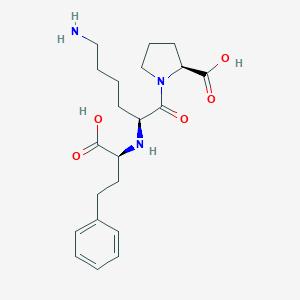
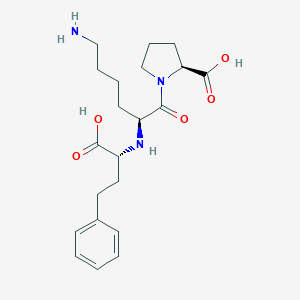
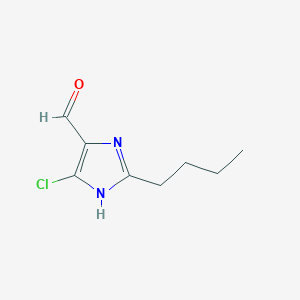
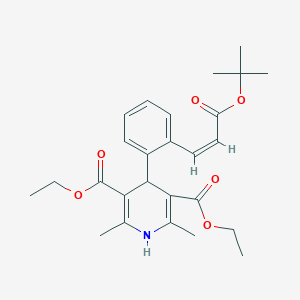
![2-[4-[[2-Butyl-4-chloro-5-(hydroxymethyl)imidazol-1-yl]methyl]phenyl]benzonitrile](/img/structure/B193149.png)
![Des[2'-(1H-tetrazol-5-yl)] 2-Cyanolosartan Carboxaldehyde](/img/structure/B193153.png)
![5-(4'-Methyl-[1,1'-biphenyl]-2-yl)-1-trityl-1H-tetrazole](/img/structure/B193154.png)
